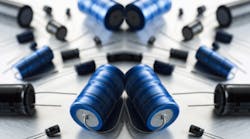With the second quarter of 2015 well underway, demand for passive electronic components has waned to the point where lead times are getting shorter—good news for anyone who is buying these parts.
“It’s basic supply and demand economics,” says Jeff Ray, vice president of corporate product supply marketing for TTI, Inc., in Fort Worth, Texas. “When the business climate slows down, lead times begin to stabilize. However, [buyers] should not confuse stabilized lead times with available-to-sell inventory. It is still very important for them to schedule their orders at full forecast to ensure a proper supply chain.”
Rewind back to 2014 and the landscape was quite different. At the time, Ray says he saw “quarter-on-quarter increases in demand” over a roughly six-quarter-long period—an environment that’s since shifted over into the buyer’s favor.
“In general, the second quarter of this year can be categorized as a ‘slower’ business climate,” says Ray. “The manufacturers’ capacity for amount of supply is more consistent with the level of business, as opposed to what we saw in 2014.”
Understanding the negative impact that a sudden decrease in lead times could have on their businesses, suppliers of passive components are looking carefully at future demand and being “pretty cautious about bringing in lead times a week here, and two weeks there,” says Ray, who is currently witnessing a “flat to slight reduction” in lead times. From a capacity utilization standpoint, passive component makers are taking a similarly cautious approach to the market for capacitors, resistors, and other passive products.
“Capacity levels are within fairly normal ranges right now,” says Ray, “versus the upper-end ranges that they were in back in 2014.”
From a vertical business standpoint, Ray says sectors such as medical, industrial, and transportation—and the industries that support them—all remain strong in 2015.
“They’re not using typical, base commodity passive products,” he points out, “but rather those that meet industrial regulatory and/or automotive standards (for instance, under-hood temperature specifications). “Those components are actually still pretty robust,” says Ray, “with lead times remaining flat to slightly extended.”
Dissecting the Business Sectors
In a recent TTI passives product and market overview, Dennis M. Zogbi wrote that passives have the highest operating margins and represent the smallest percentage of global passive component revenues, accounting for about 13% of global capacitor, resistor, and inductor revenues in fiscal year 2015.
“Key end-markets where specialty components are consumed include a myriad of fragmented segments that can broadly be categorized under the following designations: automotive under-the-hood electronics, specialty power supplies, specialty lighting ballasts, defense electronics, aerospace electronics, medical electronics, welding electronics, instrumentation and control equipment electronics, telecommunications infrastructure equipment, marine electronics (including undersea cable), mining electronics, railroad electronics, nuclear power plant electronics, and down hole pump and oil and gas equipment electronics.
According to Zogbi, the specific criteria associated with the specialty passive component markets are: 13% of global consumption value for all passive components is specialty in nature; specialty component markets can largely be found in the United States, Germany, Japan, the United Kingdom, France, and Korea; component shipment volumes are low; and component prices are high. In addition, he writes that component price volatility is limited, end-product life cycles are usually five to 10 years or more, vendors have advanced technical capabilities and close customer relationships, and “products are usually high voltage, high frequency, or high temperature in nature, and in many instances a combination of these criteria is inherent in the parts.”
Three Trends for 2015
In 3 trends in passives for 2015, Newark element14’s Larisa Miles writes about how passive component makers are shifting toward products that are smaller, more reliable, and more powerful. She points to the use of polymer and hybrid capacitors, high-density resistors, and higher-current magnetics as the top three trends that are currently playing out within the passives sector.
“These three trends in particular—smaller components, higher capacities, and polymer and hybrid capacitors—will ring especially true in the tantalum, aluminum, and polymer verticals,” Miles writes. “As the demand for smaller, better, faster, and stronger design solutions across a wide range of industries surges, so will the need for passives that can keep up. The burden will be on manufacturers and distributors to invest in technologies that can meet those demands.”








